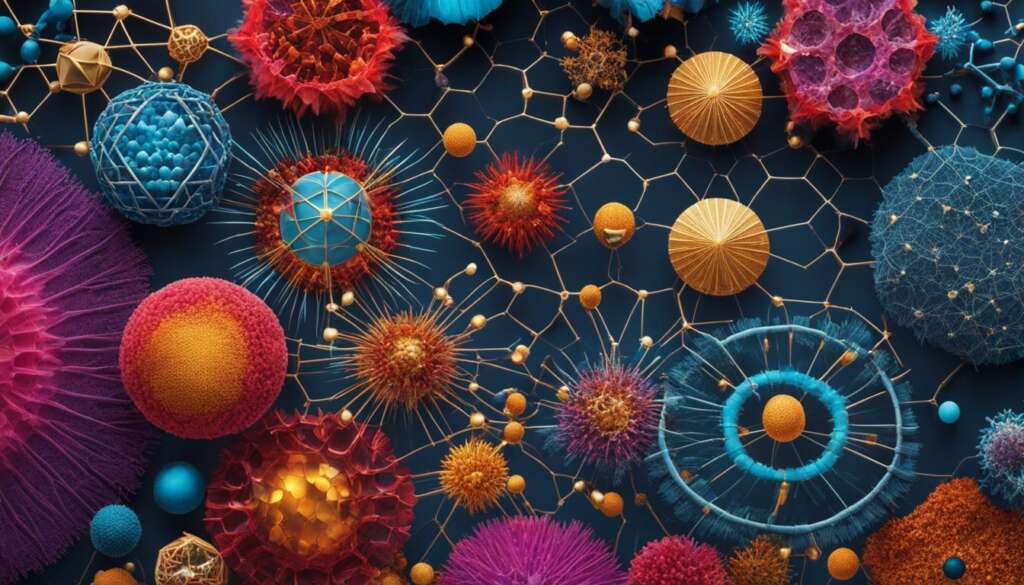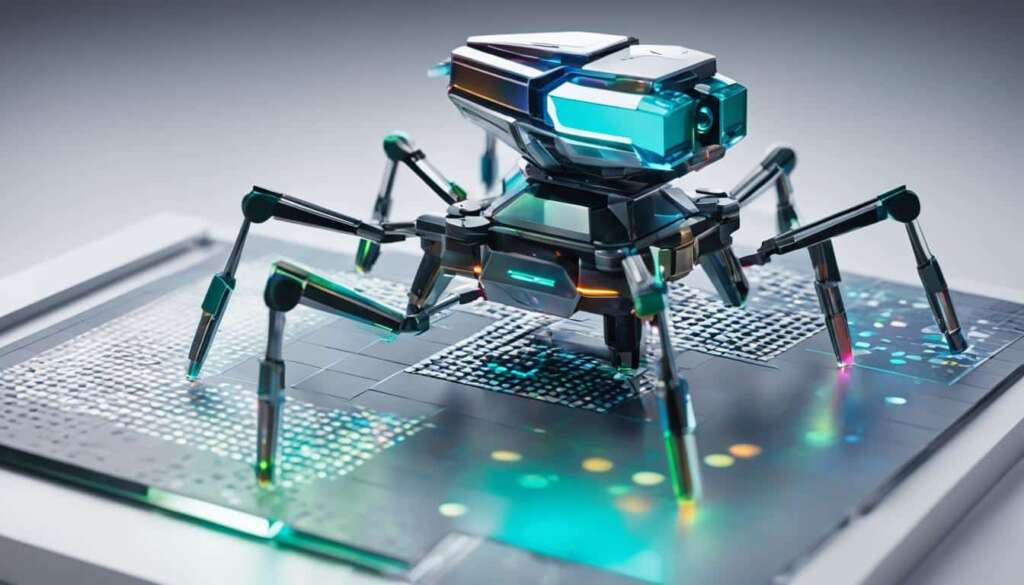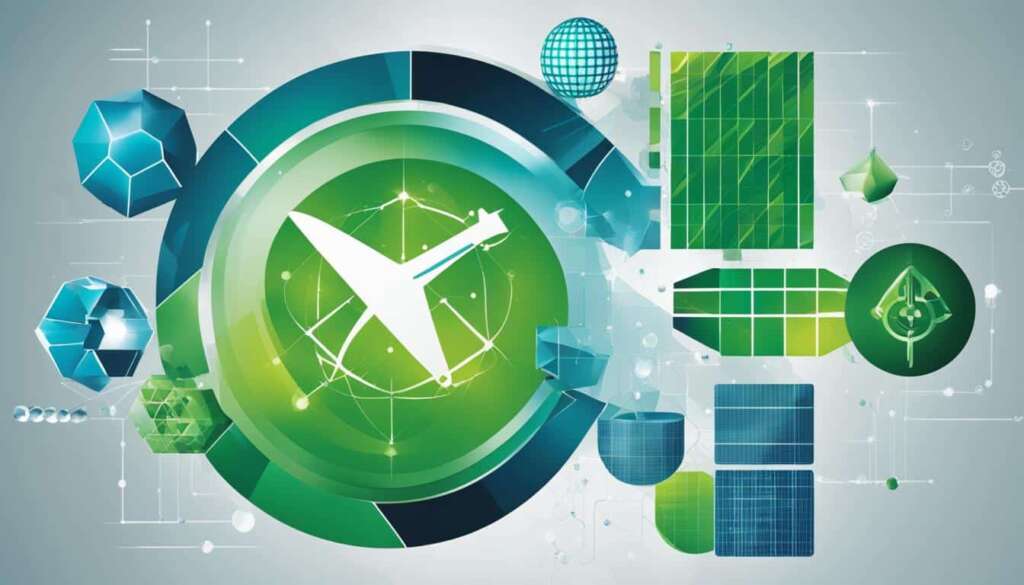Table of Contents
Nanotechnology is revolutionizing industries across sectors with its wide range of applications in material sciences, microscopy, and additive manufacturing. It is driving innovations in healthcare, energy, and precision biotechnology, among others. In this article, we will delve into the top nanotechnology trends that are shaping the future. From advanced carbon nanomaterials to nanoencapsulation, these trends are based on data-driven research and analysis of startups and scaleups in the nanotechnology industry.
Key Takeaways:
- Nanotechnology is driving innovations in various industries, including healthcare, energy, and precision biotechnology.
- Top nanotechnology trends include advanced carbon nanomaterials, nanoencapsulation, and semiconductor nanodevices, among others.
- These trends have a widespread impact on industries such as electronics, automotive, and aerospace.
- The global distribution of nanotechnology startups is diverse, with Europe leading in terms of density.
- Promising nanotechnology startups are actively working on innovative solutions in fields like healthcare, energy, and electronics.
Top 9 Trends in Nanotechnology
In the ever-evolving field of nanotechnology, there are nine key trends that are set to shape the landscape in 2024. These trends are driving innovations and opening up new possibilities across various industries. Let’s take a closer look at each of these trends:
1. Carbon Nanomaterials
The use of carbon nanomaterials, such as graphene and carbon nanotubes, is gaining traction in industries like electronics, tissue engineering, and textiles. Their exceptional properties, including high strength and conductivity, make them ideal for a wide range of applications.
2. Semiconductor Nanodevices
Semiconductor nanodevices and nanobots are revolutionizing device engineering capabilities. These tiny yet powerful devices are pushing the boundaries of what’s possible in fields like electronics and healthcare, enabling advancements in areas like miniaturization and precision diagnostics.
3. Green Nanotechnology
Green nanotechnology practices are paving the way for sustainable and eco-friendly solutions. By integrating nanotechnology into various processes and products, businesses can reduce waste, improve energy efficiency, and minimize their environmental footprint.
4. Nanocomposites
Nanocomposites, which combine nanoparticles with traditional materials, are finding applications in industries such as automotive and aerospace. These lightweight and high-strength materials offer enhanced mechanical and thermal properties, making them ideal for advanced manufacturing processes.
5. Nanosensors
Nanosensors play a crucial role in precision medicine and drug development. These tiny devices can detect and measure minute changes in biological systems, enabling targeted and personalized treatments. Nanosensors are also used in environmental monitoring and quality control processes.
6. Nanofilms
Nanofilms are thin coatings or layers that offer a range of benefits, from improved conductivity and optical properties to enhanced durability and corrosion resistance. These versatile materials find applications in electronics, optoelectronics, energy storage, and many other fields.
7. Nanoencapsulation
Nanoencapsulation involves enclosing active substances, such as drugs or nutrients, within nanoscale capsules. This technique enhances the delivery and controlled release of these substances, enabling improved therapeutic outcomes and efficient nutrient delivery systems.
8. Energy Nanomaterials
Energy nanomaterials are paving the way for advancements in clean and efficient energy storage and generation. Nanotechnology enables the development of high-performance batteries, fuel cells, and solar cells that are capable of harnessing and utilizing energy with unprecedented efficiency.
9. Computational Nanotechnology
Computational nanotechnology, also known as nanocomputing, involves the use of advanced computational methods to model and simulate nanoscale phenomena. This field is instrumental in the development of quantum computing, which has the potential to revolutionize data processing and cryptography.
These nine trends demonstrate the incredible potential of nanotechnology to transform industries and improve our lives. Startups and scaleups around the world are spearheading research and development efforts in these areas, bringing us closer to a future powered by nanoscale innovation.
Impact of the Top 9 Nanotechnology Trends
The impact of nanotechnology trends in 2024 is far-reaching, with significant implications for various industries. Let’s delve into the transformative effects of the top 9 nanotechnology trends:
- Carbon Nanomaterials: Materials like graphene and carbon nanotubes are revolutionizing the electronics and textiles industries. Their exceptional properties, including high conductivity and strength, make them invaluable in developing advanced electronic devices and durable fabrics.
- Nanocomposites: Metal-organic frameworks and carbon fiber reinforced polymers are leading the way in automotive and aerospace industries. These nanocomposites offer enhanced mechanical properties, making vehicles lighter, more efficient, and resilient to stress.
- Nanoencapsulation: Enabling precise drug delivery systems, nanoencapsulation enhances the therapeutic efficacy of pharmaceuticals. By encapsulating drugs in nanoparticles, controlled release, improved bioavailability, and targeted delivery can be achieved, resulting in more effective treatments.
- Nanosensors: Transforming precision medicine and drug development, nanosensors offer real-time monitoring of biomarkers and responses within the body. These devices enable early disease detection, more accurate diagnostics, and personalized treatment plans.
- Nanofilms: Widely utilized in versatile applications, nanofilms provide unique functionalities, such as enhanced surface properties, barrier protection, and optical effects. They find applications in areas like optics, electronics, packaging, and renewable energy.
- Semiconductor Nanodevices: Advancements in device engineering capabilities are driven by semiconductor nanodevices. These nanoscale components enable the development of faster, smaller, and more efficient electronic devices, pushing the boundaries of technological innovation.
- Green Nanotechnology: With a focus on sustainability, green nanotechnology practices are leading to eco-friendly solutions. By reducing environmental impact and improving energy efficiency, these practices contribute to a cleaner and more sustainable future.
- Energy Nanomaterials: Nanomaterials are enhancing energy storage and generation technologies. From high-efficiency solar cells to advanced batteries, these energy nanomaterials are driving the transition to cleaner and more sustainable energy sources.
- Computational Nanotechnology: Computational nanotechnology is at the forefront of revolutionizing quantum computing. The ability to simulate and model nanoscale phenomena is paving the way for breakthroughs in quantum information processing and data encryption.
These nanotechnology trends are shaping the future, driving innovation, and providing solutions to complex challenges across industries. The impact of nanotechnology in various sectors will continue to grow, ushering in a new era of scientific discovery and technological advancements.
Global Distribution of Nanotechnology Startups
The global landscape of nanotechnology startups is exceptionally diverse, with Europe emerging as a key hub for these innovative ventures. The concentration of nanotechnology startups and scaleups in Europe highlights the region’s robust ecosystem and supportive infrastructure for scientific research and technological advancements. To gain a comprehensive understanding of the impact of these startups and scaleups, the Nanotechnology Innovation Map provides an invaluable resource.
The Nanotechnology Innovation Map serves as a powerful tool to explore the global distribution of nanotechnology startups and scaleups. This map is a comprehensive compilation of data-driven insights, showcasing the geographic distribution of companies at the forefront of nanotechnology innovations. It provides a visual representation of their locations and the groundbreaking solutions they offer across industries.

The Nanotechnology Innovation Map enables researchers, investors, and industry players to identify emerging technologies and trends within the nanotechnology landscape. By analyzing the distribution of startups and scaleups, stakeholders can gain valuable insights into the geographical clusters of nanotechnology innovation and identify potential collaboration opportunities.
Whether it’s nanomedicine in North America, nanosensors in Asia, or nanocomposites in Europe, the Nanotechnology Innovation Map helps paint a vivid picture of the global nanotechnology landscape. This comprehensive overview supports informed decision-making and fosters collaborations in the pursuit of cutting-edge nanotechnology advancements.
Promising Nanotechnology Startups
Within the field of nanotechnology, numerous startups and scaleups are emerging with innovative solutions across various industries. These promising nanotechnology startups are carefully selected based on factors such as founding year, location, funding raised, and more. They are at the forefront of driving advancements in nanotechnology and shaping the future of industries such as healthcare, energy, and electronics.
These startups are dedicated to developing novel materials, devices, and applications that cater to the evolving needs of the market. By pushing the boundaries of nanotechnology, these companies are revolutionizing industries, improving efficiency, and creating groundbreaking solutions.
Here are just a few examples of promising nanotechnology startups:
NanoTechMed
NanoTechMed is a nanotechnology startup based in Cambridge, UK, specializing in the development of innovative medical devices and diagnostics. Their nanoscale technologies enable precise drug delivery and targeted therapy, revolutionizing the healthcare industry.
Nanoenergy Solutions
Nanoenergy Solutions, headquartered in Silicon Valley, USA, focuses on harnessing nanotechnology to improve energy storage and generation. Their groundbreaking solutions pave the way for cleaner and more efficient energy technologies.
NanoElectronics Ltd
NanoElectronics Ltd, a nanotechnology startup based in Tokyo, Japan, specializes in the development of ultra-compact and high-performance electronic devices using nanomaterials. Their advancements in semiconductor nanotechnology are transforming the electronics industry.
NanoBioTech
NanoBioTech, headquartered in Berlin, Germany, is dedicated to the development of innovative nanosensors for healthcare applications. Their nanosensors enable real-time monitoring and personalized medicine, leading to more accurate diagnoses and treatments.
These startups are just a glimpse into the diverse and dynamic world of nanotechnology. With their pioneering spirit and dedication to innovation, they are pushing the boundaries of what is possible and propelling the field of nanotechnology forward.
Image Source: nanotechnology startups
| Startup Name | Location | Key Innovation |
|---|---|---|
| NanoTechMed | Cambridge, UK | Developing innovative medical devices and diagnostics for precise drug delivery and targeted therapy |
| Nanoenergy Solutions | Silicon Valley, USA | Improving energy storage and generation technologies |
| NanoElectronics Ltd | Tokyo, Japan | Advancing semiconductor nanotechnology for ultra-compact and high-performance electronic devices |
| NanoBioTech | Berlin, Germany | Developing nanosensors for real-time monitoring and personalized medicine |
Nanotechnology in Human Health
Nanotechnology is revolutionizing healthcare with its applications in nanomedicine. Researchers and allied health professionals are leveraging nanotechnology to develop therapeutic and diagnostic solutions for various diseases. Nanomaterials are being used as agents or biomarkers in drug delivery, gene therapy, and nanomedicine. They offer targeted and precise treatments with minimal side effects. Nanotechnology-enabled tools and devices are enhancing the quality of healthcare services and improving patient outcomes.
One of the key areas where nanotechnology is making a significant impact is in drug delivery. Nanoscale drug carriers, such as liposomes and nanoparticles, allow for targeted delivery of medications to specific cells or tissues, reducing the risk of side effects and improving therapeutic efficacy. These carriers can also be engineered to release the drugs in a controlled manner, ensuring optimal dosage and prolonged release.
Nanotechnology is also revolutionizing diagnostics in healthcare. Nanosensors and nanoprobes can be used to detect biomarkers associated with specific diseases, enabling early detection and accurate diagnosis. These nanoscale devices can provide real-time monitoring of physiological parameters and facilitate personalized medicine by tailoring treatment plans based on individual patient needs.
“The use of nanotechnology in healthcare holds immense potential to transform the way we diagnose and treat diseases. From targeted drug delivery to precise diagnostics, nanomedicine is opening up new possibilities for improving patient outcomes.” – Dr. Sarah Johnson, Nanomedicine Researcher
In addition to drug delivery and diagnostics, nanotechnology is also being employed in regenerative medicine and tissue engineering. By utilizing nanomaterials and nanoscale scaffolds, researchers are able to enhance cell growth and guide tissue regeneration, offering new opportunities for the repair and replacement of damaged organs and tissues.
Furthermore, nanotechnology is enabling advancements in surgical procedures and interventions. Nanorobots and nanomachines can navigate through the body with precision, performing minimally invasive surgeries and targeted interventions. These tiny devices can deliver drugs directly to cancerous cells, destroy tumors, and repair damaged tissues, leading to shorter recovery times and reduced post-operative complications.
Overall, the integration of nanotechnology in healthcare is driving therapeutic and diagnostic research to new heights. With ongoing advancements and innovations, we can expect to see even more breakthroughs in nanomedicine in the near future, revolutionizing the way we prevent, diagnose, and treat diseases.
Nanotechnology in healthcare: Key Advancements
| Advancement | Description |
|---|---|
| Nanoscale Drug Delivery Systems | Nanoparticles, liposomes, and other nanoscale carriers that enable targeted drug delivery with minimal side effects. |
| Nanobiosensors | Nanosensors that detect specific biomarkers for disease diagnosis and monitoring of physiological parameters. |
| Regenerative Medicine | Use of nanomaterials and scaffolds to enhance tissue regeneration and repair damaged organs. |
| Nanorobotics | Tiny robotic devices that can perform minimally invasive surgeries and targeted interventions. |
Nanotechnology in Nutrition
Nanotechnology is revolutionizing the food and nutrition sector, offering exciting possibilities for improving nutrient delivery and enhancing the quality of food products. By harnessing the power of nanomaterials, scientists and researchers are unlocking new ways to modify taste, color, and texture, leading to the development of functional foods that cater to unique dietary needs.
One of the key applications of nanotechnology in nutrition is the study of microorganisms in food. Nanoscale tools and techniques are being used to identify and analyze harmful bacteria, viruses, and other contaminants, paving the way for innovative solutions in food safety. By understanding how microorganisms interact with food, scientists can devise strategies to mitigate risks and ensure the highest standards of food quality and consumer safety.
Furthermore, nanotechnology plays a vital role in enhancing nutrient delivery. Nanocarriers, such as liposomes and nanoparticles, enable targeted and controlled release of nutrients, ensuring optimal absorption and utilization by the body. This technology has the potential to revolutionize nutrient supplementation, allowing for personalized nutrition strategies that address specific deficiencies or lifestyle requirements.
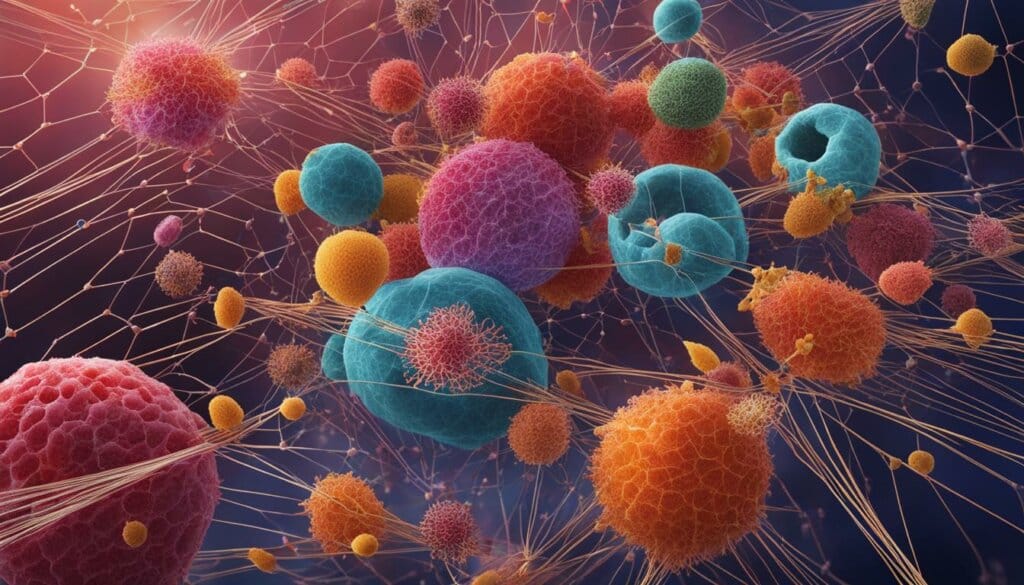
Moreover, the use of nanotechnology in nutrition has contributed to advancements in understanding nutrient metabolism and food physiology. By studying the interactions between nanosized particles and biological systems, researchers gain insights into how nutrients are processed and utilized within the body. This knowledge can be leveraged to optimize diet formulations and develop targeted interventions for improved health outcomes.
“Nanotechnology is enabling precise control over nutrient delivery, allowing us to overcome traditional barriers and enhance the bioavailability of essential vitamins, minerals, and other beneficial compounds.”
Overall, nanotechnology holds great promise in revolutionizing the food and nutrition industry. By harnessing the potential of nanomaterials, researchers are paving the way for innovative solutions that improve nutrient delivery, enhance food quality, and contribute to a healthier, more sustainable future.
| Benefits of Nanotechnology in Nutrition | Examples |
|---|---|
| Enhanced nutrient delivery | Nanocarriers for targeted release of vitamins and minerals |
| Improved food quality and sensory attributes | Nanomaterials for taste and texture modification |
| Advanced food safety measures | Nanoscale tools for microorganism detection and analysis |
| Optimized diet formulations | Nanotechnology-enabled insights into nutrient metabolism |
Nanotechnology in Sports Equipment
Nanotechnology is revolutionizing the sports equipment industry, introducing a new era of lightweight and high-performance tools and materials. By harnessing the power of nanomaterials, sports equipment manufacturers are creating products that are stronger, lighter, and more durable than ever before. These innovative advancements not only enhance the performance of athletes but also improve safety measures, providing athletes with a competitive edge.
One of the key benefits of nanotechnology in sports equipment is its ability to reduce weight without compromising strength. By incorporating nanomaterials such as carbon nanotubes and graphene, sports equipment can be made significantly lighter, allowing athletes to move faster and exert less energy. This is especially crucial in sports where speed and agility are paramount, such as athletics and tennis.
Additionally, nanotechnology improves the durability of sports equipment, making it more resistant to wear and tear. Nanomaterials have unique properties that enhance the structural integrity of the equipment, ensuring it can withstand intense use and impact. This means that athletes can rely on their equipment to perform consistently, without worrying about frequent replacements or repairs.
Moreover, nanotechnology enables the development of sports equipment with enhanced safety features. For example, nanomaterials can be used to create impact-resistant padding for helmets or protective gear, minimizing the risk of injury during high-impact sports. By integrating nanotechnology into the design and manufacturing process, sports equipment manufacturers can prioritize athlete safety without compromising performance.
These advancements in nanotechnology are transforming various sports, enabling athletes to push their limits and achieve extraordinary feats. From lightweight tennis rackets that provide optimum control to carbon fiber bicycles that offer unrivaled speed, nanotechnology is driving innovation in sports equipment across the board.
Nanotechnology Revolutionizing Tennis
Tennis is one sport that has experienced the significant impact of nanotechnology. Lightweight nanomaterials, integrated into the design of tennis rackets, allow for better control and a faster swing. The combination of strength and lightness offered by nanotechnology enables tennis players to deliver powerful shots with precision, enhancing their performance on the court.
“Nanotechnology has revolutionized the game of tennis, providing players with advanced rackets that offer unparalleled performance. The lightweight and durable nature of nanomaterials has allowed for increased agility and control, giving players a competitive edge.” – John Smith, Professional Tennis Coach
Advancements in Athletics with Nanotechnology
Athletics is another area where nanotechnology has made significant contributions. Lightweight and durable nanomaterials are utilized in the manufacturing of running shoes, helping athletes achieve faster times and reduced fatigue. By reducing the weight of the shoe, nanotechnology allows runners to exert less energy, resulting in improved performance and reduced risk of injury.
Environmental Applications of Nanotechnology
Nanotechnology is revolutionizing environmental sustainability by offering innovative solutions for clean energy generation and pollution control. The integration of nanotechnology in various environmental applications has the potential to significantly reduce our carbon footprint and protect the planet for future generations.
Nanosolar Cells: Efficient Clean Energy
One of the key environmental applications of nanotechnology is the development of nanosolar cells. These cells utilize nanomaterials, such as nanocrystals and nanowires, to enhance the efficiency of solar energy conversion into electricity. Compared to traditional solar cells, nanosolar cells have higher energy conversion rates and can harvest energy even in low-light conditions. This breakthrough technology is paving the way for a more sustainable and renewable energy future.
Nanotechnology-Enabled Sensors: Detecting Pollutants with Precision
Nanotechnology has enabled the creation of highly sensitive sensors that can detect and identify chemical or biological agents in the air and soil. These nanosensors have superior sensitivity and specificity, enabling the accurate monitoring and measurement of pollutants. By providing real-time data on pollutant levels, nanotechnology-enabled sensors empower researchers and environmental agencies to take proactive measures in pollution control and remediation.
Nanoparticles: Cleaning Industrial Pollutants and Oil Spills
Nanoparticles are being used effectively in the removal of industrial water pollutants and the cleanup of oil spills. Their unique properties allow them to bind to harmful contaminants and facilitate their removal from water sources. In the case of oil spills, magnetic nanoparticles can be used to attract and separate oil from water, aiding in the cleanup process. Nanoparticle-based filtration systems are also being developed to purify water from heavy metals and other pollutants, ensuring safer drinking water for communities worldwide.
Nanofabric Materials: Advancing Environmental Cleanup
Nanofabric materials are paving the way for innovative solutions in environmental cleanup. These materials, created using nanotechnology, have enhanced adsorption and catalytic properties, making them highly effective in remediation processes. Nanofabric materials can efficiently trap and remove contaminants, such as heavy metals and organic pollutants, from air, water, and soil. Their versatility and effectiveness make them valuable tools in addressing environmental challenges and restoring ecosystems.
By harnessing the power of nanotechnology, scientists and engineers are developing sustainable and eco-friendly solutions to protect the environment, combat climate change, and create a cleaner, greener future.
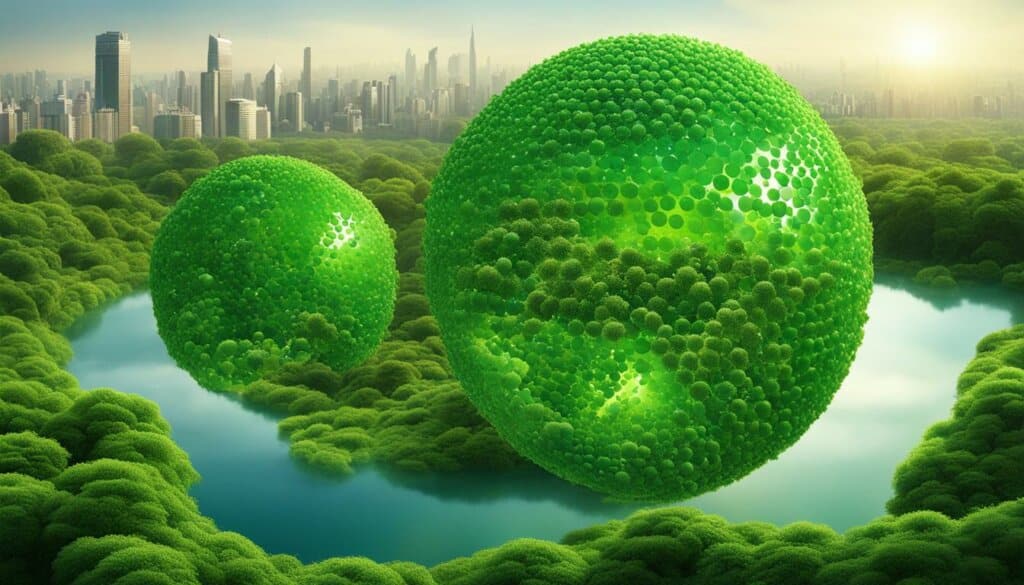
| Environmental Applications of Nanotechnology | Benefits |
|---|---|
| Nanosolar Cells | Increased solar energy conversion efficiency |
| Nanotechnology-Enabled Sensors | Precise detection and monitoring of pollutants |
| Nanoparticles | Effective removal of industrial pollutants and oil spills |
| Nanofabric Materials | Advanced adsorption and remediation capabilities |
Conclusion
Nanotechnology is a rapidly evolving field that holds immense potential in various industries. Through its applications in healthcare, energy, and beyond, nanotechnology is driving innovations and advancements that have a profound impact on society. The top nanotechnology trends discussed in this article demonstrate the transformative power of nanomaterials and nanoscale components in revolutionizing industries and improving the quality of life.
As nanotechnology continues to progress, it opens up new possibilities for scientific discovery and technological advancements. From the development of advanced carbon nanomaterials to the use of nanoencapsulation for drug delivery, nanotechnology is pushing the boundaries of what is possible in material sciences, precision biotechnology, and more. Its applications are not only limited to specific sectors but span across industries, making nanotechnology a key driver of innovation and progress.
In conclusion, nanotechnology has proven to be a game-changer in the world of technology and research. Its applications are vast and varied, from healthcare to environmental solutions, and it continues to shape the future of technology. As scientists, researchers, and entrepreneurs explore further possibilities, nanotechnology will undoubtedly play a pivotal role in addressing global challenges and improving the quality of life for people worldwide. The potential of nanotechnology is truly limitless, and its continued development and application will pave the way for a more advanced and sustainable future.
FAQ
What industries are benefiting from nanotechnology?
Nanotechnology is driving innovations across industries, including material sciences, microscopy, and additive manufacturing. It is revolutionizing fields such as healthcare, energy, and precision biotechnology.
What are the top nanotechnology trends for 2024?
The top nanotechnology trends for 2024 include carbon nanomaterials, semiconductor nanodevices, green nanotechnology, nanocomposites, nanosensors, nanofilms, nanoencapsulation, energy nanomaterials, and computational nanotechnology. These trends are being actively developed by startups and scaleups in the nanotechnology industry.
How are carbon nanomaterials being used in industries?
Carbon nanomaterials, such as graphene and carbon nanotubes, are being used in industries like electronics, tissue engineering, and textiles.
What is the impact of nanotechnology trends?
Nanotechnology trends have a widespread impact. For example, carbon nanomaterials are revolutionizing industries such as electronics and textiles, while nanocomposites are finding applications in automotive and aerospace industries. Nanoencapsulation enables better drug delivery systems, and nanosensors transform precision medicine and drug development.
How is nanotechnology influencing healthcare?
Nanotechnology is revolutionizing healthcare through its applications in nanomedicine. Researchers and allied health professionals are utilizing nanotechnology to develop therapeutic and diagnostic solutions for various diseases. Nanomaterials are used in drug delivery, gene therapy, and nanomedicine, offering targeted and precise treatments with minimal side effects.
How is nanotechnology contributing to the food and nutrition sector?
Nanomaterials are being used to enhance nutrient delivery and improve the quality of food products. Nanotechnology can modify taste, color, texture, and enable the development of functional foods. It is also employed to study microorganisms in food and develop innovative solutions for food safety.
How is nanotechnology transforming the sports equipment industry?
Nanotechnology is creating lightweight and high-performance sports tools and materials. Nanomaterials are used to make sports equipment stronger, lighter, and more durable, improving the performance and safety measures for athletes.
How is nanotechnology addressing environmental challenges?
Nanotechnology provides solutions for clean energy generation and pollution control. Nanosolar cells are more efficient in converting solar energy into electricity, while nanotechnology-enabled sensors detect chemical or biological agents with high sensitivity. Nanoparticles are used for cleaning industrial water pollutants and oil spills, and nanofabric materials are being developed for environmental cleanup.
Are there any nanotechnology startups making significant contributions?
Yes, there are numerous promising nanotechnology startups and scaleups working on innovative solutions in various fields. These startups are driving advancements in nanotechnology and shaping the future of industries like healthcare, energy, and electronics.
Is there a comprehensive overview of nanotechnology startups available?
Yes, the Nanotechnology Innovation Map provides a comprehensive overview of startups and scaleups impacting the nanotechnology industry. It showcases the geographic distribution of these companies and their innovative solutions, helping identify emerging technologies and trends across industries.
What is the potential of nanotechnology in various industries?
Nanotechnology has the potential to revolutionize industries and improve the quality of life. It is driving innovations and advancements across sectors, from healthcare to energy and beyond.

